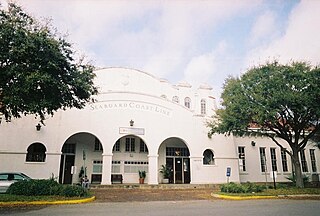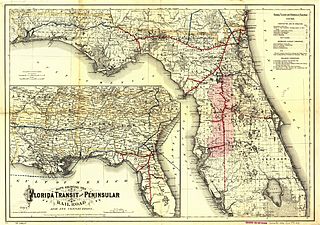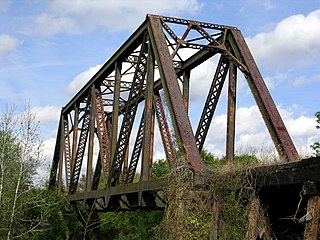
The Seaboard Air Line Railroad, known colloquially as the Seaboard Railroad during its time, was an American railroad that existed from April 14, 1900, until July 1, 1967, when it merged with the Atlantic Coast Line Railroad, its longtime rival, to form the Seaboard Coast Line Railroad. Its predecessor railroads dated from the 1830s and reorganized extensively to rebuild after the American Civil War, and by 1900 had merged together to form the SAL. The company was headquartered in Portsmouth, Virginia until 1958, when its main offices were relocated to Richmond, Virginia.

The Atlantic Coast Line Railroad was a United States Class I railroad formed in 1900, though predecessor railroads had used the ACL brand since 1871. In 1967, it merged with long-time rival Seaboard Air Line Railroad to form the Seaboard Coast Line Railroad. Much of the original ACL network has been part of CSX Transportation since 1986.

The Louisville and Nashville Railroad, commonly called the L&N, was a Class I railroad that operated freight and passenger services in the southeast United States.

Orlando Health/Amtrak station, also known as Orlando station, is a train station in Orlando, Florida. It is served by Amtrak, the national railroad passenger system of the United States, and SunRail, the commuter rail service of Greater Orlando, as well as local and intercity buses. It serves Amtrak's Silver Meteor and Floridian lines. Built in 1926, the historic station is located in Downtown Orlando approximately one mile south of the central business district, near the campus of Orlando Health. Serving 160,442 passengers at last measure in 2013, The station is Amtrak's fifth busiest in the Southeastern United States; it is the second busiest Amtrak station in Florida, behind the Sanford station of the Auto Train.

The Florida Central and Peninsular Railroad was the final name of a system of railroads throughout Florida, becoming part of the Seaboard Air Line Railway in 1900. The system, including some of the first railroads in Florida, stretched from Jacksonville west through Tallahassee and south to Tampa. Much of the FC&P network is still in service under the ownership of CSX Transportation.

The Ocala Union Station is a bus station and former train station in Ocala, Florida, United States. It is located at 531 Northeast First Avenue, and was built in 1917 by both the Atlantic Coast Line and Seaboard Air Line Railroad. Prior to this, ACL and SAL had separate depots in Ocala. The former ACL station was originally built by the Florida Southern Railroad, while the former SAL station was built by the Florida Transit and Peninsular Railroad. On December 22, 1997, it was added to the U.S. National Register of Historic Places.

The Union Station built in 1930 in Atlanta was the smaller of two principal train stations in downtown, Terminal Station being the other. It was the third "union station" or "union depot", succeeding the 1853 station, burned in mid-November 1864 when Federal forces left Atlanta for the March to the Sea, and the 1871 station.

The Royal Palm was a named train of the Southern Railway that ran from Cincinnati, Ohio, to Jacksonville, Florida, and then on the Florida East Coast Railway's East Coast Champion to Miami, Florida. The train was discontinued in 1970.

The Champion was a streamlined passenger train operated by the Atlantic Coast Line Railroad and Florida East Coast Railway between New York City and Miami or St. Petersburg, Florida. It operated from 1939 until 1979, continuing under the Seaboard Coast Line and Amtrak. It was a direct competitor to the Seaboard Air Line Railway's Silver Meteor, the first New York-Florida streamliner.
The South Wind was a named passenger train equipped and operated jointly by the Pennsylvania Railroad, the Louisville and Nashville Railroad, the Atlantic Coast Line Railroad, and the Florida East Coast Railway. The South Wind began operations in December 1940, providing streamliner service between Chicago, Illinois and Miami, Florida. This was one of three new seven-car, all-coach streamliners operating in coordination every third day along different routes between Chicago and Miami. The other two longest enduring Chicago-Florida trains were the City of Miami and the Dixie Flagler. The South Wind remained in service through the creation of Amtrak in 1971.

The City of Miami was a seven-car coach streamliner inaugurated by Illinois Central Railroad on December 18, 1940. Its route was from Chicago to Miami a total distance of 1,493 miles (2,403 km).

Wildwood station is a bus station, and former train station, in Wildwood, Florida. It serves Amtrak Thruway buses and formerly served trains for Amtrak and other rail companies. The station is located on 601 North Main Street in Wildwood, Florida. Along with the northern terminus of Florida's Turnpike, the station gave Wildwood a reason to refer to itself as "The Crossroads of Florida."

The Dixie Flagler was a streamlined passenger train operated by the Florida East Coast Railway (FEC) between Chicago, Illinois and Miami, Florida. It began in 1939 as the Henry M. Flagler, a regional service between Miami and Jacksonville, Florida; the FEC renamed it and extended it to Chicago a year later. It was one of the few Chicago to Florida trains that passed through Atlanta. As an overnight streamliner it was part of the every-third-day pool shared by the City of Miami and South Wind. It was renamed Dixieland in 1954 and discontinued altogether in 1957.
The Tampa Southern Railroad was a subsidiary of the Atlantic Coast Line Railroad (ACL) originally running from Uceta Yard in Tampa south to Palmetto, Bradenton, and Sarasota with a later extension southeast to Fort Ogden in the Peace River valley built shortly after. It was one of many rail lines completed during the Florida land boom of the 1920s. It was later known as the Atlantic Coast Line's Tampa—Southfort Line and Tampa—Sarasota Line on employee timetables. Most of the remaining trackage now serves as CSX Transportation's Palmetto Subdivision. Another short portion just east of Sarasota also remains that is now operated by Seminole Gulf Railway.

The Dixie Flyer was a premier named American passenger train that operated from 1892 to 1965 via the "Dixie Route" from Chicago and St. Louis via Evansville, Nashville, and Atlanta to Florida. However, the train continued until 1969 as an Atlanta to Florida operation, run solely by the Atlantic Coast Line Railroad and its successor, the Seaboard Coast Line. The Flyer's route varied in early years, but by about 1920 was set as follows:
The Flamingo was a passenger train operated by the Louisville and Nashville Railroad and the Atlantic Coast Line Railroad between Cincinnati, Ohio, and Jacksonville, Florida, from the 1920s to the 1960s. It carried coaches and sleeping cars.

The Kansas City–Florida Special was a pooled night train and the premier train of the Frisco Railroad and the Southern Railway. Operating from Kansas City, Missouri to Jacksonville, Florida, it was unique as being one of very few long distance passenger train to traverse the Mississippi River south of St. Louis, Missouri and north of New Orleans, Louisiana.
The Southland was a night train between Chicago, Illinois and different points in western and eastern Florida from 1915 to 1957. In the early years it was called the New Southland. It was distinctive among Midwest to Florida trains as its western branch was the only all-season mid-20th-century long-distance train passing from Georgia to Florida bypassing the usual passenger train hub of Jacksonville Union Station. The main operator was the Louisville and Nashville Railroad, and pooling partners were the Pennsylvania Railroad, the Atlantic Coast Line Railroad and to lesser extent, the Wabash Railroad and the Florida East Coast Railway. For southeast bound -but not northwest bound- trips to Norfolk, Virginia, some coaches in 1946 diverged at Cincinnati along a Norfolk and Western Railway route. Northwest bound, travelers could switch trains at Cincinnati for heading towards Chicago.
The Atlantic Coast Line Railroad's Perry Cutoff was a historic rail line in northern Florida running from Monticello southeast to Perry. The line provided a shortcut through the Big Bend of Florida for rail traffic running between the Midwest and the Tampa Bay area by providing a more direct route and a bypass for the busy rail hub in Jacksonville. It was completed in 1928 to reduce travel times for its passenger trains to the west coast, or Gulf Coast, of Florida during the Florida land boom of the 1920s.

The Seaboard Air Line Railroad's Sarasota Subdivision was a rail line that ran from the company's main line at Turkey Creek south to Palmetto, Bradenton, Sarasota, and Venice. The line was built in phases from 1901 to 1911.
















